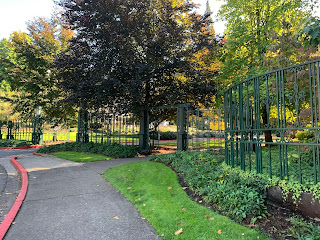The first thing that struck me upon landing in Portland, and then again in Eugene, is how green and lush everything is. You can smell it in the air. I think I’ve acclimated to California, which is brown a good portion of the year, and I’d sadly forgotten how lush other places can be. Flying into Portland I could sand waves in the Columbia River and Mt Hood off in the distance.
While at
the workshop, they mentioned a few times how we were discussing subduction zone
modeling while sitting atop the Cascadia subduction zone, arguably the greatest
geologic threat to the northwestern US.
Much of the first day was talking about different types of
slip along the megathrust, from various types of aseismic slip to devastating
earthquakes. Aseismic slip is slip that doesn’t register on seismometers.
Examples include earthquakes that are too small and don’t radiant enough
energy, low-frequency tremor, and my current favorite: slow slip events, or
silent earthquakes. Slow slip events can last hours to months (the longest ones
observed have lasted ~1.5 years). The rupture is very slow, but above the
normal plate motion rate. The amount of slip accommodated over the duration of
these events can be quite large, equivalent to a magnitude 7 earthquake.
 |
| image credit: FEMA |
The workshop then got into dynamic slip and tsunami
modeling. Dynamic slip modeling involves modeling co-seismic slip (slip along
the plate boundary during an earthquake) to learn more about the rupture
process, earthquake source parameters, and fault properties. Tsunami modeling
uses outputs from dynamic rupture models (the amount of slip and surface
deformation) to determine the size, energy, and inundation that might occur
during an earthquake-triggered tsunami. There is currently a big effort to
couple these models together, so that the tsunami models are informed as the modeled
slip during the earthquake is occurring, rather than waiting for the net
result. It is not just the total amount of slip and deformation that matters
for a tsunami, a lot can depend on where and how the slip develops.
Finally, we got into geodynamic and
surface process modeling. This is the type of modeling I’m most interested in
at the moment. How does the geometry of the megathrust affect fault behavior
and earthquake slip? We know the dip of the subducting plate is very important
to the amount of friction along the plate boundary interface and the size of
the locked portion of the fault. The locked portion is the part of the fault
that is assumed to slip in large, devastating earthquakes. How does the
topography and surface roughness of the plate boundary interface affect the structural
development of the fault? While dynamic slip modeling is interested in the few
second to minutes of fault slip and deformation that occurs during the
earthquakes, or just after and before the earthquakes (pre- and post-slip),
geodynamical modeling is typically interested in plate boundary slip and deformation
that happens over geological time scales of thousands to millions of years.
However, these models can be used to inform each other, and the work should not
be done in isolation. This was one of the motivating factors of the workshop.
To better understand subduction zone processes, we need to facilitate
collaboration between all the different groups doing subduction zone research.
There was a previous workshop earlier
this year that focused on fluid transport through subduction zones, and there will
be a final workshop next year on modeling volcanic systems. The presentations
and breakout session notes (where key questions related to fluid transport were
posed to the attendees) for the fluid transport workshop are already online,
and the white paper summary of the meeting is coming soon. The same materials
will also be available for the megathrust modeling workshop, and eventually for
the future volcanic systems modeling workshop. The idea of the MCS RCN to be as
open and transparent as possible so that these discussions benefit the
community at large. These workshops are meant to generate a consensus in the
subduction zone science community as to what some of the primary areas of focus
should be and to guide future NSF proposals to allow the develop of a community
model.
I found the workshop to be very
informative, and I met some great people that I look forward to being able to
collaborate with in the future. The presentations and breakout discussions were
fantastic, and I certainly feel motivated to pursue this field of science.





